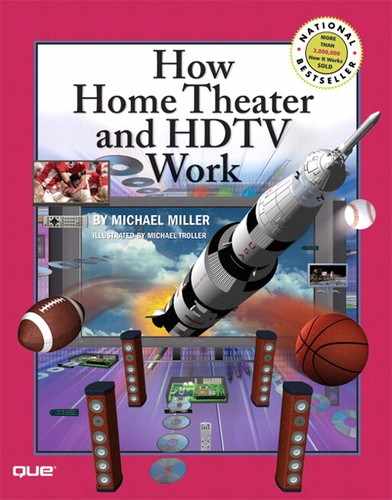
Now that you know about all the different types of video displays available, how do you choose the right display for your own home theater system? As you can tell, it’s definitely not a one-size-fits-all world.
The following pages will help guide you through this decision by comparing the pluses and minuses of each type of display. In general, however, each of the display technologies is best for specific uses:
Direct-view—. Good for smaller rooms or when you’re sitting only 5 or 6 feet away from the screen, when you have to deal with high ambient light levels, when you want the brightest possible picture and a wide viewing angle, or if you’re on a tight budget.
Rear projection—. Good if you have a larger room but want to make as few compromises as possible in terms of room lighting or viewing angle. Also a good choice if you prefer to watch movies in their original aspect ratio without worrying about screen burn-in.
Front projection—. The best choice if you want the largest picture possible and the closest approximation to a movie theater experience—and don’t mind restricting both viewing angle and room lighting.
Flat-panel—. Good if you have little or no floor space for a television set or projector—or if you just want to show off the neat technology. Plasma flat panels are especially popular when you want a larger picture, but they present somewhat of a burn-in problem.
When choosing a set, you should also consider the number and types of video inputs on the back, the usability of the remote control, and any additional features offered (such as picture-in-picture and onscreen program guides). You should definitely get a set that’s ready for HDTV broadcasts and that offers a 16:9 aspect ratio screen. And make it a point to audition each set with similar programming—not all sets using the same technology are created equal!
Technology used: CRT
Pros:
Excellent color and film-like picture
Affordable
Cons:
Big and bulky
Limited screen sizes (40” max.)
Technologies used: CRT, DLP, LCD, LCoS
Pros:
Self-contained units
Large screen sizes (up to 70”)
Cons:
Big and bulky (microprojectors less so)
Less bright than direct view sets
Technologies used: CRT, DLP, LCD
Pros:
One size fits all (variable picture size)
Capable of extra-large pictures (100” or more)
Cons:
Low light output requires a darkened room
Requires special screen for best performance
Technologies used: LCD and plasma
Pros:
Thin and wall-mountable
Easy to place in almost any room
Cons:
Expensive
Not all models are true HDTV; beware lower-priced EDTV models
Display Type | Technology | Current Screen Sizes | Thickness | Viewing Angle (Off center) | Contrast Ratio and Black Level | Potential for Screen Burn-in | Pros | Cons |
|---|---|---|---|---|---|---|---|---|
Direct view | CRT | 5”–40” | 20”–25” | 85° | Excellent | Moderate | Best picture quality of all display types. Lowest-priced technology. | Screen size limited. Big and heavy. |
Rear projection | CRT | 42”–65” | 22”–28” | 30°–45° | Very good | Moderate | Lowest-priced RPTV sets. Film-like picture. | Big and bulky. Less light output than other RPTVs. Three CRTs require convergence. |
DLP | 48”–62” | 15”–20” | 75° | Good | None | Brightest Picture of all RPTVs. Excellent blacks and shadow details. More compact technology than CRT projectors. Some high-end models offer 1980 × 1080 native resolution. | Moving parts (color wheel). Some viewers sensitive to “rainbows.” Lamp replacement. | |
LCD | 42”–70” | 15”–20” | 60°–65° | Moderate–good | None | No “rainbows” or burn-in. Good brightness and color reproduction. More compact technology than CRT projectors. | Limited contrast and black level. Possible “screen door” effects. Lamp replacement. | |
LCoS | 52”–70” | 16”–22” | 80° | Good | None | First RPTV technology to offer 1980 × 1080 native resolution. No “rainbows” or burn-in. Smoother, more cinematic picture than DLP or LCD projectors. | Not widely adopted. Expensive. Lamp replacement. | |
Front aprojection | CRT | 70”+ | N/A | 50°–90° (dependent on type of screen) | Very good | Moderate | Film-like picture. Highest-resolution display (w/ 9” CRTs). Best suited for high-end professional installations. | Low light output requires a darkened room. Three CRTs require convergence. |
DLP | 70”+ | N/A | 50°–90° (dependent on type of screen) | Good | None | Extremely affordable. Brightest FPTV picture. Small projector size. | Moving parts (color wheel). Some viewers sensitive to “rainbows.” Lamp replacement. | |
LCD | 70”+ | N/A | 50°–90° (dependent on type of screen) | Moderate–good | None | No “rainbows.” Brighter than CRT projectors. Small projector size. | Limited contrast and black level. Possible “screen door” effects. Lamp replacement. | |
Flat-panel | LCD | 13”–50” | 4”–5” | 70°–85° | Good | None | Weighs less and uses less energy than plasma. Wall mountable. No burn-in. | Vulnerable to “motion smear.” Expensive, especially at larger screen sizes. Limited contrast and black level. |
Plasma | 32”–61” | 4”–5” | 80° | Very good | High | Closest picture to that of traditional CRT. Excellent off-axis viewing. Wall-mountable. | Vulnerable to burn-in. Glass panel is fragile. Expensive. |
Viewing Distance | Ideal 4:3 SDTV Screen Size | Ideal 16:9 HDTV Screen Size |
|---|---|---|
6’ | 24” diagonal | 36” diagonal |
7’ | 28” diagonal | 42” diagonal |
8’ | 32” diagonal | 48” diagonal |
9’ | 36” diagonal | 54” diagonal |
10’ | 40” diagonal | 60” diagonal |
11’ | 44” diagonal (not available) | 66” diagonal |
12’ | 48” diagonal (not available) | 72” diagonal |

